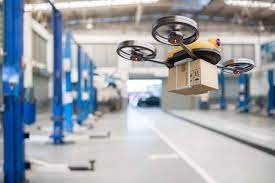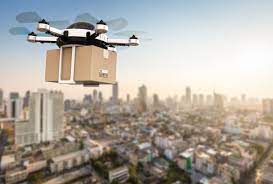In recent years, drone technology has been rapidly advancing, and one area where it has the potential to revolutionize the way we do things is package transportation and delivery. With the growth of e-commerce and the increasing demand for faster and more efficient delivery, drone delivery has emerged as a promising solution. In this article, we will explore the future of drone delivery and package transportation, including the benefits and challenges, the current state of technology, and its potential impact on society.
Benefits of Drone Delivery
The benefits of drone delivery are numerous. For one, it can significantly reduce delivery times, especially in urban areas where traffic congestion can cause delays. Drones can fly directly to the delivery address without having to navigate through traffic, which means packages can be delivered much faster than with traditional ground-based delivery services. This is particularly important for time-sensitive deliveries, such as medical supplies or perishable goods.

Another benefit of drone delivery is cost efficiency. Drones have lower operating costs than traditional delivery vehicles, and they can also cover a larger area in a shorter amount of time. This means that companies can offer more affordable delivery options to customers, which can help to drive sales and increase customer satisfaction.
Drone delivery can also reduce the environmental impact of transportation. Traditional delivery vehicles contribute to air pollution and greenhouse gas emissions, but drones run on electricity, which is much cleaner and more sustainable. This makes drone delivery an eco-friendly option that can help to reduce the carbon footprint of the transportation industry.
Challenges of Drone Delivery
Despite the potential benefits, several challenges need to be addressed before drone delivery can become a widespread reality. One of the biggest challenges is safety. Drones can potentially collide with other aircraft, buildings, or people, which can cause serious damage or injury. There are also concerns about the security of the packages being transported and the potential for drones to be hacked or intercepted.
Another challenge is the limited range and payload capacity of current drone technology. Most drones can only travel a few miles and carry a few pounds of cargo, which makes them impractical for transporting larger or heavier items. This means that drone delivery may only be feasible for certain types of packages, such as small electronics or lightweight groceries.
The regulatory environment is also a major hurdle to the widespread adoption of drone delivery. In many countries, drones are subject to strict regulations, including requirements for registration, licensing, and certification. There are also restrictions on where and when drones can fly, which can make it difficult to implement a large-scale drone delivery system.
Current State of Technology
Despite the challenges, there has been significant progress in drone technology in recent years. Companies such as Amazon, Google, and UPS have all been investing heavily in drone delivery research and development, and several pilot programs have been launched in different parts of the world.
One of the key areas of innovation has been drone design. New drones are being developed that are more durable, have longer battery life, and can fly faster and farther than previous models. There has also been progressing in the development of autonomous drone technology, which can fly and navigate without human intervention.
In addition, there has been progressing in the development of ground-based infrastructure to support drone delivery. This includes the development of reports, which are specialized facilities designed to support the launch, landing, and maintenance of drones. There has also been progressing in the development of software and systems to manage and control drone traffic, which will be critical for ensuring the safety and efficiency of drone delivery.
Potential Impact on Society
The widespread adoption of drone delivery could have a significant impact on society. For one, it could help to create new jobs and industries. As drone delivery becomes more widespread, there will be a need for pilots, technicians, and support staff to manage and maintain the system. This could help to boost local economies and provide new career opportunities for people in a range of fields.
Drone delivery could also improve access to goods and services in remote or underserved areas. In many parts of the world, access to reliable transportation and delivery services is limited, which can make it difficult for people to access essential goods such as medical supplies or fresh food. Drone delivery has the potential to overcome some of these challenges by providing a fast and reliable way to transport goods to these areas.
In addition, drone delivery could help to reduce traffic congestion and air pollution in urban areas. With more and more people living in cities, the demand for delivery services is increasing, which has led to a significant increase in traffic congestion and air pollution. Drone delivery could help to alleviate some of this pressure by providing a faster and more efficient delivery option.

Conclusion
In conclusion, drone delivery has the potential to revolutionize the way we transport and deliver goods. While there are still significant challenges that need to be addressed before it can become a widespread reality, there has been significant progress in drone technology in recent years, and several pilot programs are already underway.
If drone delivery can overcome the challenges and be adopted on a large scale, it could bring significant benefits to society, including faster and more efficient delivery, cost savings, and reduced environmental impact. It could also create new jobs and industries and improve access to goods and services in underserved areas.
Overall, the future of drone delivery and package transportation looks promising, and it will be exciting to see how this technology evolves and transforms the transportation industry in the years to come.
However, it is important to ensure that the development and implementation of drone delivery are done responsibly, with safety, privacy, and security considerations taken into account. Governments, regulators, and industry players must work together to establish clear standards and guidelines for drone delivery to ensure that it is safe and reliable.
There are also concerns about the potential impact of drone delivery on employment, particularly for workers in the traditional delivery industry. As drone delivery becomes more widespread, there is a risk that it could lead to job losses in the sector. It is important to consider the potential social and economic impact of drone delivery and to ensure that any job losses are mitigated through retraining and other support measures.
In conclusion, drone delivery is an exciting and promising technology that has the potential to transform the way we transport and deliver goods. While there are still challenges that need to be addressed, the progress made in drone technology in recent years suggests that these challenges can be overcome. If implemented responsibly, drone delivery could bring significant benefits to society and help to create a more sustainable and efficient transportation industry.










